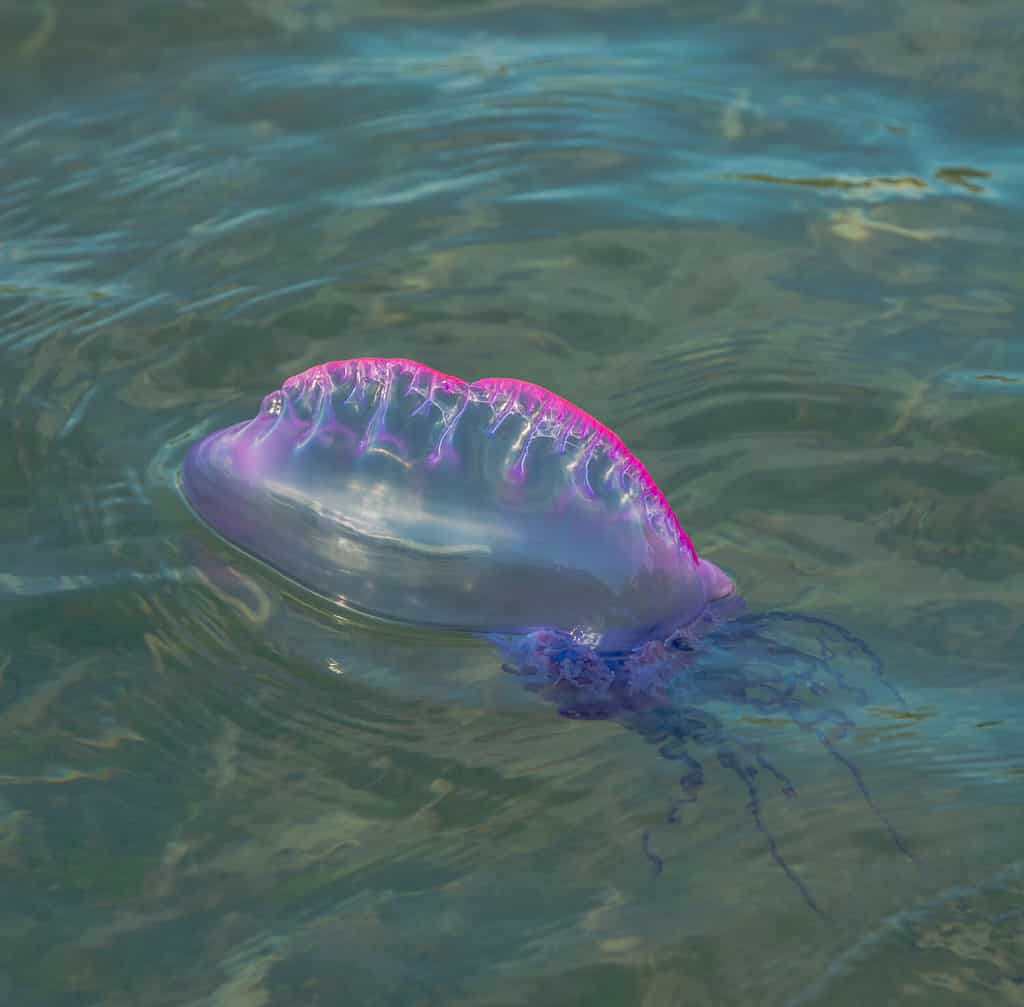One animal is a colony made up of individuals that work together while the other is a single organism, acting alone. Both are venomous. But in a battle between a Portuguese man-of-war vs. a stingray, which sea creature emerges victorious? Let’s find out!
Portuguese Man-Of-War vs. Stingray: Which Deep Sea Creature Would Win in A Fight?
| Portuguese Man-Of-War | Stingray | |
|---|---|---|
| Size | Tentacles on average 30 feet long (can be over 100 feet) Float is only six inches tall | On average 4.6 to 8.2 feet wide |
| Speed and Movement | Movement and speed are entirely dependent on the movement and speed of the water | Up to 30 miles per hour; undulating movements |
| Defenses | Venomous nematocysts | Venomous stinging tentacles |
| Offensive Capabilities | Long stinging tentacles | Nematocysts sting upon touch; strong jaws to crush prey |
| Predatory Behavior | Attacks upon touch | Camouflages in the sand; use fins to capture prey and draw it closer |
What Are the Key Differences Between a Portuguese Man-Of-War and a Stingray?
When considering a conceptual battle between a Portuguese man-of-war and a stingray, you must consider their key differences. How big each creature gets is notable as well as how it moves in the water. How they defend themselves, what their offensive capabilities are, and how they hunt all come into play as well.

The Portuguese man-of-war is often mistaken for a jellyfish.
©Broadbelt/Shutterstock.com
Portuguese Man-Of-War vs. Stingray: Size
The Portuguese man-of-war has a unique, eye-catching appearance. It’s comprised of multiple individuals known as zooids that all work together in a colony. It looks kind of like a jellyfish because of its long tentacles. Sometimes they can grow over 100 feet long but on average, their tentacles reach about 30 feet long. Their floats are only six inches tall. Stingrays are, on average, 4.6 to 8.2 feet wide. Some of the most common only reach a couple of feet but the wingspan of larger species extends out further.
Portuguese Man-Of-War vs. Stingray: Speed and Movement
The Portuguese man-of-war primarily relies on the movement of the body of water it’s in. They drift instead of swimming, letting the currents of the ocean determine their speed and direction. They have to go with the flow as they cannot swim against a current. Stingrays can swim and move in an undulating motion. They’re quite agile and can swim up to 30 miles per hour in short bursts.
Portuguese Man-Of-War vs. Stingray: Defenses
The Portuguese man-of-war has one primary defense: its stinging tentacles. Their tentacles are covered with nematocysts, which are the cells that take care of the venomous stinging. Not only are these painful upon touch, but they can also be quite dangerous. Stingrays are equipped with venom of their own. However, instead of stinging cells being distributed throughout their bodies, they have their venom localized on their stinging barb. If threatened, a stingray is likely to swim or hide but as a last resort, it uses its tail to inject venom.

Stingrays have a venomous barbed tail they use to defend themselves and attack prey.
©tristan tan/Shutterstock.com
Portuguese Man-Of-War vs. Stingray: Offensive Capabilities
The Portuguese man-of-war captures prey within its long tentacles, immobilizing smaller organisms like fish and pelagic crustaceans with its venom. Stingrays also snack on small fish and are known to feast on worms, shrimp, and oysters as well. When they spot prey, they draw it closer with their fins and use their strong jaws to crush through their prey before consuming it. Stingrays also have specialized organs that can pick up on the electrical charges their prey emanate, which gives them an advantage even when the water is murky.
Portuguese Man-Of-War vs. Stingray: Predatory Behavior
Since the Portuguese man-of-war relies on the movement of the water, it can’t hunt in the same way a stingray can. As these sea creatures drift together in their colony, they employ passive predation, taking whatever opportunity presents itself to feed. Small fish and other small organisms that happen to brush against a Portuguese man-of-war get stung and consumed. Stingrays are also opportunistic but more active when they hunt. They look for prey animals and hide their bodies in the sand to ambush them when they get close enough.
Who Wins in a Fight Between Portuguese Man-Of-War and a Stingray?
In a fight between a Portuguese man-of-war and a stingray, a Portuguese man-of-war would win. Assuming it’s the largest possible Portuguese man-of-war versus the largest stingray, the stinging tentacles of the Portuguese man-of-war could do serious damage to a stingray’s body. A stingray, though also venomous, only has its barbed tail to rely on, instead of its entire body being covered with stinging cells. Although a stingray is an active swimmer, once it’s entangled in the Portuguese man-of-war’s tentacles, it’s unlikely to find its way out. Each micro movement would result in yet another set of painful stings.
The photo featured at the top of this post is ©
Thank you for reading! Have some feedback for us? Contact the AZ Animals editorial team.






